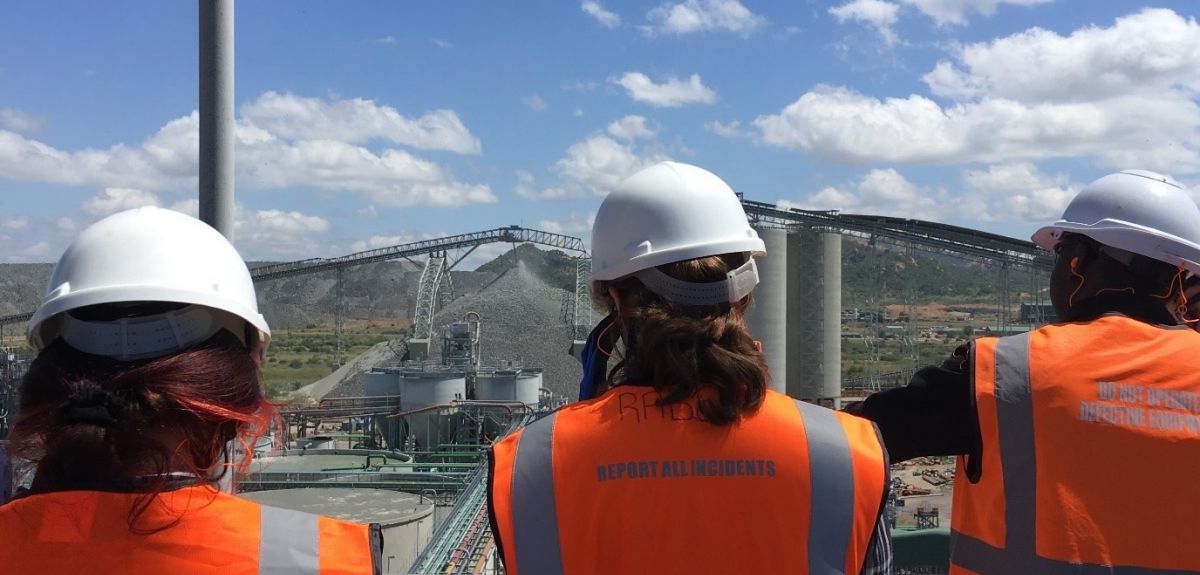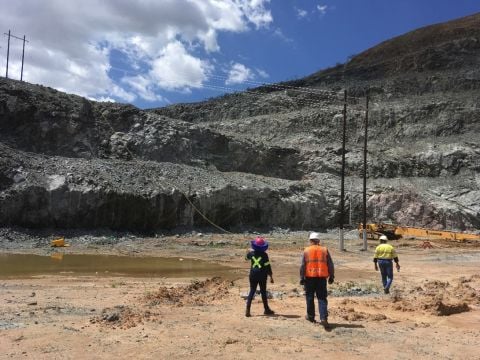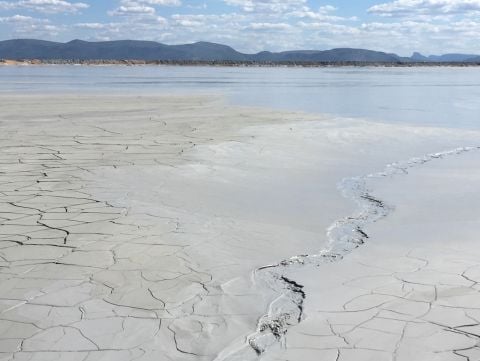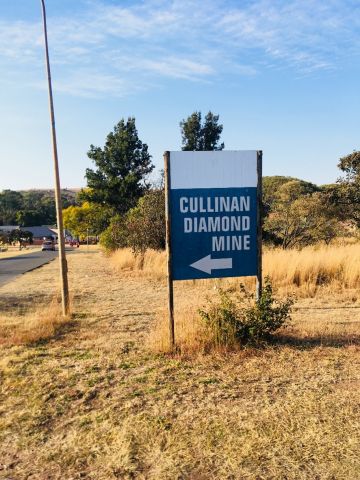
Credit: Liam Bullock
Could South African mine wastes provide a feasible storage method for millions of tonnes of CO2?
By Liam Bullock, Zakhele Nkosi and Maxwell Amponsah-Dacosta
Having visited just a few of the many metal and diamond mines of South Africa, my colleagues and I are never short of astonishment of the sheer scale and efficiency of the operations.
 Some stretch for tens of kilometres in length, width and even depth. The size of the mines, coupled with the riches in the ground that are targeted, require town-sized populations coming on and off-site 24 hours a day, as the Earth is upheaved, moved, crushed, and divided for the valuable commodities.
Some stretch for tens of kilometres in length, width and even depth. The size of the mines, coupled with the riches in the ground that are targeted, require town-sized populations coming on and off-site 24 hours a day, as the Earth is upheaved, moved, crushed, and divided for the valuable commodities.
Moving from the rock faces through to the concentrators and beyond, one cannot help but be both impressed and intimidated by the volumes of material that is cascading through the system.
Mine sites are literally well-oiled machines, and it is easy to witness both the pros and cons that sites have on our society. However, hidden in plain sight among the hectic operations is perhaps the biggest untapped source of material that could help us in our ongoing battle with climate change. A material often perceived as having a negative effect on the environment – mine wastes known as tailings.
Negative Emissions Technologies
The means of climate mitigation that could be met here is through the implementation of “negative emissions technologies” (NETs) at mine sites. These methods aim to remove carbon dioxide (CO2) from the atmosphere, addressing one of the biggest societal challenges we face as a collective.
 The gathering movement to NETs and CO2 removal forms part of a greater global response to limit temperature increase to well below 2 °C over the next few decades, as outlined by the Intergovernmental Panel on Climate Change (IPCC).
The gathering movement to NETs and CO2 removal forms part of a greater global response to limit temperature increase to well below 2 °C over the next few decades, as outlined by the Intergovernmental Panel on Climate Change (IPCC).
There are several possible NET methods of CO2 removal, including the advancing notion of utilising “enhanced weathering of rocks”. The method involves speeding up the chemical breakdown of rocks, a natural process that converts atmospheric CO2 into carbonate minerals or hydrogen carbonate and carbonate ions (“alkalinity”).
Basalt, a common fast-weathering volcanic rock at the Earth’s surface, has been marked as a highly appropriate rock type for both direct CO2 injection (as demonstrated by the pioneering CarbFix Project) and deployment through spreading crushed basaltic rocks on croplands. South Africa is built upon similarly reactive rocks, and the mining industry of the nation has delivered a ready-made batch of finely ground rock for any future CO2 removal strategies.
Mine waste potential
Hidden in plain sight among the hectic operations is perhaps the biggest untapped source of material that could help us in our ongoing battle with climate change.
Mine tailings, which are the leftover rock material that remains following the extraction of the targeted commodity, are typically mud- to sand-like in size, and are stored on sites in dams and containment areas. While their hazardous properties such as their associated toxicity and threat of dam burst mean that tailings have often been considered nothing more than problematic, the millions of tonnes that are annually produced may actually represent a possible environmental solution.
The key is to identify the right types of mine tailings and find the most suitable method for enhanced weathering. The principle of enhanced weathering to mimic and accelerate natural chemical weathering, whereby minerals dissolve and react with atmospheric CO2 and water (rainwater, a weak carbonic acid), with the resultant bicarbonate solutions transported to oceans by rivers, where they are stored as alkalinity. The bicarbonate products may also later precipitate as carbonate minerals. Either way, the reaction results in a net uptake of CO2 from the atmosphere, trapping CO2 on a permanent basis.
It’s all in the de-tail
 Silicate rocks such as basalt are favourable for such reactions due to their high abundance of magnesium and calcium-rich minerals, which react readily with CO2 in the natural environment. Other rocks which contain these favourable minerals and chemistry are kimberlites, which host diamonds, and layered mafic intrusions, which can contain high amounts of platinum group metals, nickel, copper and chrome.
Silicate rocks such as basalt are favourable for such reactions due to their high abundance of magnesium and calcium-rich minerals, which react readily with CO2 in the natural environment. Other rocks which contain these favourable minerals and chemistry are kimberlites, which host diamonds, and layered mafic intrusions, which can contain high amounts of platinum group metals, nickel, copper and chrome.
A number of studies have pointed to sequestration schemes at South Africa’s prominent diamond and platinum operations as a possible step towards addressing the climate crisis. Kimberlites and layered mafic intrusions host many of the expansive diamond and metal deposits of South Africa, including the world-famous Bushveld Complex, the largest layered igneous intrusion within the Earth's crust and home to approximately 80% of platinum group metal ore reserves.
The result of this wealth of resources is the production of millions of tonnes of waste material. Chemically, the waste material does not differ significantly from the original rock, making it a potentially hefty source for CO2 removal strategies. Overall, South African diamond and platinum mine wastes could represent one of the largest untouched CO2 removal sources in the world.
Getting up to speed
The problem with the natural weathering process as a practical solution to climate change is that it is a slow one, taking hundreds of thousands of years to occur and the uptake amount is dwarfed by the amount released through fossil fuel emissions. Therefore, enhanced weathering aims to speed up the chemical weathering rates such that CO2 is scrubbed from the atmosphere in meaningful quantities on human timescales, such as in decades rather than millennia.
Overall, South African diamond and platinum mine wastes could represent one of the largest untouched CO2 removal sources in the world.
The challenge of enhanced weathering is to find methods that speed up magnesium and calcium release from minerals, without producing more CO2 or other greenhouse gases. Enhanced weathering methods include crushing the material to give high reactive surface areas. The advantage of mine tailings is that the material has already been crushed to these favourable fine grain sizes during the extraction process, so this step has already been achieved.
Another possible enhanced weathering method is to increase the temperature and pressure of the reaction, but you run the risk of running up CO2 through emission intensive methods by this process. Direct CO2 stream injection (compared to the more diluted atmospheric CO2) means the rate of sequestration is less limited by rate of CO2 supply, speeding up the reaction. Additionally, biotechnologies and microbial acceleration processes may increase mineral dissolution and precipitation rates, with some additives and sorbents promoting increased reaction times. In order to speed up reactions to capture CO2 on human timescales, one or more of these methods is required. The question is – how can this be realistically achieved?
Time for action
In order to answer this question, desktop studies, laboratory experiments and site pilot schemes are required. Crucially, the time to act as now, and the mining industry recognises this. Where tailings were perhaps once perceived as a nuisance, mine companies now see the opportunity, and they are actively investigating the potential to capture CO2 at their own sites.
The time to act as now, and the mining industry recognises this.
The diamond mining company De Beers have launched their own carbon storage research project on their sites, including the kimberlite-rich tailings of their South African operations.
Their parent company, Anglo American, are working together with researchers from the Universities of Southampton, Oxford, Herriot Watt and Cambridge, as well as academic partners in South Africa, to investigate the viability of enhanced weathering methods at their Mogalakwena platinum mine site in the Bushveld Complex (GGREW Project).
The SAT4CCS project, led by researchers from the universities of Pretoria, Oxford and Cape Town, aims to assemble detailed information on tailings across South Africa. The aim is to identify the total potential for CO2 sequestration in the South African mining sector. The end-product will be a comprehensive catalogue, atlas and online database for available and suitable tailings, with recommendations for possible future CO2 sequestration project sites across the country.
The next few years will be crucial in the outcome of enhanced weathering as a viable method in the South African mining industry, requiring closer collaboration between industry, governments and scientists. Enhanced weathering of rocks at mine sites is not the silver bullet that can meet climate change targets set out in the Paris Agreement, but can form an integral part of the greater global movement to tackling climate change.
The SAT4CCS team
The ongoing database development of mine tailings in South Africa is being led by:
• Zakhele Nkosi, PhD candidate, lecturer and researcher in Applied Mineralogy and Historical Geology at the University of Pretoria, with a focus on diamond mine tailings for mineral carbonation and CO2 removal.
• Liam Bullock, Postdoctoral Research Assistant in Chemical Engineering at the University of Oxford, and member of the Greenhouse Gas Removal by Enhanced Weathering project.
• Maxwell Amponsah-Dacosta, PhD candidate at the University of the Western Cape who conducted his Masters’ research on the mineralogical characterization of South African mine tailings for the purpose of mineral carbonation.